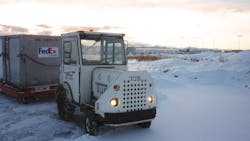Five Maintenance Tips To Keep GSE Running In Winter
It is no secret that the cold weather of winter can have significant impact on our ground support equipment, and for that matter, cars and trucks. The colder it gets the greater the impact to engines, suspensions, tires, glass, locks and a host of other associated parts.
This makes a preventative maintenance program very important leading up to winter weather.
In preparation for this article I recently spoke to Pat Cunningham, station manager for Matheson Flight Extenders, Inc. in Anchorage. With a cargo operation that runs 24 hours a day throughout the year, if anyone knows the impact of cold weather on equipment, it would be Pat and his crew.
The Anchorage market creates some unique challenges during the winter that may not be found in your neighborhood. But, even so, many of the issues are common wherever temperatures drop and warrant mention.
1. Change to winter weight oil: Engines are susceptible to cold weather because they need lubricants and they need coolant. Depending on how harsh your winters are there may be a need for a different grade of oil in winter versus summer.
Most vehicles today use common 10-40 weight oil that is great if you live in a mild climate. But extreme cold weather may demand a lower viscosity product like a 5-30W to help cirulate the lubricant within the engine.
So an oil change leading into the winter months is always a good idea. Check your owner’s manual for what works best for your vehicle.
2. Clean battery posts and connectors: Battery cranking power is another area that degrades in cold weather.
Batteries produce electrons by virtue of electrolyte fluids surrounding the lead and lead dioxide plates within the cell. In cold weather, a battery doesn’t produce as many electrons and cannot produce as much cranking power.
As a result, it is important to monitor a battery throughout winter and keep the battery posts and connectors clean as well as make sure the leads to your starter and alternator are well-attached and clean. These simple things will help keep your cranking power at its maximum.
3. Tighten tire chains: Often overlooked is the impact of tire chains used during winter months. Tire chains installed on a vehicle will cause a lot of additional vibration unless you are driving on deep snow pack. In most cases, however, the snow is quickly beaten down and as it freezes forms a hard ice surface.
The chains rolling on that hard ice surface will cause the added vibration. Vibrations can cause a host of issues from loosening nuts and bolts to damaging wheel wells or even the vehicle body if a link breaks.
If you must use tire chains make sure they are tight and recheck them after their initial use. As they wear, they warm up and they can expand so keep a close watch on the bungees that keep them taught.
4. Grease all moving parts: With other equipment, such as K-Loaders, belt loaders and baggage tugs, Pat reminds us all that the best way to get through the winter unscathed is to be sure your preventative maintenance program includes greasing and tightening all moving parts.
That is essential to protect against the breakdown of chain drives, seals, u-joints and wheel bearings. These steps together with a close monitoring of fluid levels are critical to the long-term care and reliability of your equipment.
5. Keep tires properly inflated: Tires are another area that should have your attention during the winter months. Whether you realize it or not, tires have a temperature operating range where performance will degrade at extremes of temperature.
Tires get harder as the thermometer drops and the cold sets in. They lose some of their suppleness and gripping power.
Under normal conditions with an automobile the tires will build up heat during normal operation that compensates for the cold. On a baggage tug, however, where speed remains low on a ramp, tires will take longer to warm up. Be more careful while cornering, especially with other GSE in tow so the tug will not slide laterally on the driving surface.
For every 10-degree drop in temperature, the pressure in your tires can also drop about 1-2 psi per tire. So a tire properly inflated in the summertime will generally be underinflated in the winter if not checked frequently. Be sure to check those tires on a regular basis not only for proper inflation but for tread depth, too.
Now if you’re lucky enough to work in Alaska or perhaps another glacial region of the world a rather unique foe in the winter time is "glacial dust." Pat warns that this dust (a very fine particulate) can be very abrasive. Because of its fine grain it is easily transported through the air and as a result it can penetrate even the best protected systems. Keeping a close watch on your air filters, oil filters and any other filtering system is, therefore, very important. Regular changes of these filters will aid in a longer service life of the equipment.
Cold weather operations are common in many areas across this globe. Operations personnel and mechanics battle this foe every year and win because they are prepared through thoughtful preventative maintenance programs that support their organizations.
With just a few simple steps your preventative maintenance program can be effective in getting your equipment ready for cold weather operations so take a moment to review your program, and you’ll have a smooth winter operation.



